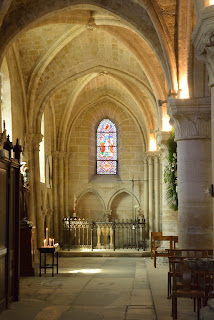Auvers Sur Oise
As much as Paris has been an inspirational hub for some of
the world’s most renowned artists, even they enjoyed a more serene escape from
time to time. And it was not only Vincent van Gogh. Paul Cézanne, Camille
Pissarro, and Jean-Baptiste-Camille Corot spent time in the same wonderful
hamlet, Auvers Sur Oise too.
Auvers Sur Oise, about 30 kilometers north of Paris, was an
escape for the ailing and tormented Vincent van Gogh. Seeking the treatment of
Dr. Paul Gachet, whom van Gogh later figured to be in an even worse state than he
was, situated himself in rooms in L’Auberge Ravoux where later he died. Today
the rooms where he stayed have been preserved, though it is no longer a rooming house. The restaurant remains much as it did in his time.
 Van Gogh spent the last few months of his life in Auvers Sur
Oise and is buried among a number of notable influential people from all walks of
life. Indeed van Gogh’s ever-supportive brother, Theo, is buried in the plot
next to him having passed away just six months after his brother. Van Gogh died
of infection from a bullet in his chest that wasn’t removed after his attempted suicide. The cemetery is just a short walk from where he painted some of
his most famous pastoral scenes.
Van Gogh spent the last few months of his life in Auvers Sur
Oise and is buried among a number of notable influential people from all walks of
life. Indeed van Gogh’s ever-supportive brother, Theo, is buried in the plot
next to him having passed away just six months after his brother. Van Gogh died
of infection from a bullet in his chest that wasn’t removed after his attempted suicide. The cemetery is just a short walk from where he painted some of
his most famous pastoral scenes. Despite this tragedy, or perhaps because of it, the city has
been persevered to be much as it was in his time. The serenity is palpable and
unmistakable. The stone buildings with colorful shutters and flower planters,
fields of corn and wheat bending in the breeze, winding paths and stairways,
gardens and churches will lower your blood pressure without a single pill in
the prescription.
Despite this tragedy, or perhaps because of it, the city has
been persevered to be much as it was in his time. The serenity is palpable and
unmistakable. The stone buildings with colorful shutters and flower planters,
fields of corn and wheat bending in the breeze, winding paths and stairways,
gardens and churches will lower your blood pressure without a single pill in
the prescription.
The city is easily accessible from Paris via an express SNCF
train from Gare du Nord in the northeasterly quarter of the city. The express
runs Saturdays and Sundays leaving Gare du Nord around 10:00 am and returning a
little after 6:00 pm from Auvers Sur Oise. The fare is less than $10.00 round
trip. If you miss the express, the trip will take about an hour and a half back
to Paris. Should you want to be certain to not miss the return train, there’s a
fine old book and magazine store built inside an old box car where you will be
right next to the station.

Central to most towns in Europe is a church, sitting high on a hill. Built before van Gogh’s time, the Church of Auvers Sur Oise is the subject of one of his paintings (now hanging in the Musée d’Orsay) and remains in full use today.
The largest building in the old city is château de Leyrit.
It seems a bit out of place given its grandeur in such an idyllic town, but
there it is with its topiary, labyrinth, fountains and gardens. Tours are
available daily.

The city has a self-guided walking tour to ensure that you
take in the various important sites it has to offer. Many of the stops along
the tour feature signs with images of the van Gogh’s vision (his completed
painting) of the area so that you can compare pretty much what he saw with what
he painted.

There are several restaurants and cafés along the town’s
main street that are perfect for lunch al fresco. One can discover
the entire hamlet on foot too so there’s simply no need for a car or even to bother with a bicycle, especially since photo opportunities abound
everywhere you look.

There also several small museums and museum gift shops where you can purchase various posters and books on van Gogh and other artists, but you’ll find no original van Gogh paintings in any of them.
Unfortunately, we had to abandon our tradition of capping off the day with a cool scoop of gelato. There were simply no gelato stands in sight.































